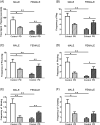Predator odor exposure of rat pups has opposite effects on play by juvenile males and females
- PMID: 27569603
- PMCID: PMC5742270
- DOI: 10.1016/j.pbb.2016.08.008
Predator odor exposure of rat pups has opposite effects on play by juvenile males and females
Abstract
Juvenile social play behavior is one of the earliest sexually differentiated behaviors to emerge. In rats, as with most other species that play, males engage in more rough-and-tumble play compared to females. Exposure to early life adversity is a major driver of adult health and can manifest differently in males and females. However, the effects of adverse early life exposure on play behavior in the juvenile period are poorly understood. To address this, male and female neonatal rats were exposed to predator odor (PO), for 5min/day on PN1-PN3. At the time of exposure to PO, both male and female pups suppressed ultrasonic vocalization and displayed more freezing behavior. Circulating corticosterone increased in males immediately following PO exposure but not in females. The enduring effects of PO exposure were opposite in males compared to females in that PO exposed males decreased social play, while PO exposed females increased play behavior compared to same sex controls. PO exposure did not significantly affect cell genesis in the neonatal dentate gyrus of either sex. PO exposure did not affect anxiety-like behavior assessed in the juvenile period or in adulthood, nor did it affect social interactions in adulthood. This work provides new insight into how sex may interact with adverse early life events to contribute to development of the social consequences of such exposures.
Keywords: Anxiety; Corticosterone; Development; Early life adversity; Predator odor; Sex differences; Social play.
Copyright © 2016 Elsevier Inc. All rights reserved.
Figures






Similar articles
-
Sex differences in traumatic stress reactivity in rats with and without a history of alcohol drinking.Biol Sex Differ. 2020 May 11;11(1):27. doi: 10.1186/s13293-020-00303-w. Biol Sex Differ. 2020. PMID: 32393336 Free PMC article.
-
Sex-dependent effects of Cacna1c haploinsufficiency on juvenile social play behavior and pro-social 50-kHz ultrasonic communication in rats.Genes Brain Behav. 2020 Feb;19(2):e12552. doi: 10.1111/gbb.12552. Epub 2019 Jan 15. Genes Brain Behav. 2020. PMID: 30592145
-
Pre-pubertal stress exposure affects adult behavioral response in association with changes in circulating corticosterone and brain-derived neurotrophic factor.Psychoneuroendocrinology. 2009 Jul;34(6):844-58. doi: 10.1016/j.psyneuen.2008.12.018. Epub 2009 Jan 31. Psychoneuroendocrinology. 2009. PMID: 19181453
-
Behavioural and neurochemical consequences of early weaning in rodents.J Neuroendocrinol. 2009 Mar;21(4):427-31. doi: 10.1111/j.1365-2826.2009.01837.x. J Neuroendocrinol. 2009. PMID: 19207810 Review.
-
Double helix: reciprocity between juvenile play and brain development.Dev Cogn Neurosci. 2011 Oct;1(4):459-70. doi: 10.1016/j.dcn.2011.07.001. Epub 2011 Jul 13. Dev Cogn Neurosci. 2011. PMID: 22436567 Free PMC article. Review.
Cited by
-
Brain, behavior, and physiological changes associated with predator stress-An animal model for trauma exposure in adult and neonatal rats.Front Mol Neurosci. 2024 Feb 29;17:1322273. doi: 10.3389/fnmol.2024.1322273. eCollection 2024. Front Mol Neurosci. 2024. PMID: 38486962 Free PMC article.
-
Retrotransposons and the brain: Exploring a complex relationship between mobile elements, stress, and neurological health.Neurobiol Stress. 2025 Jan 18;34:100709. doi: 10.1016/j.ynstr.2025.100709. eCollection 2025 Jan. Neurobiol Stress. 2025. PMID: 39927173 Free PMC article. Review.
-
Identifying the most effective behavioural assays and predator cues for quantifying anti-predator responses in mammals: a systematic review.Environ Evid. 2023 Apr 1;12(1):5. doi: 10.1186/s13750-023-00299-x. Environ Evid. 2023. PMID: 39294799 Free PMC article.
-
Smell and Stress Response in the Brain: Review of the Connection between Chemistry and Neuropharmacology.Molecules. 2021 Apr 28;26(9):2571. doi: 10.3390/molecules26092571. Molecules. 2021. PMID: 33924992 Free PMC article. Review.
-
The Divergent Effects of CDPPB and Cannabidiol on Fear Extinction and Anxiety in a Predator Scent Stress Model of PTSD in Rats.Front Behav Neurosci. 2019 May 10;13:91. doi: 10.3389/fnbeh.2019.00091. eCollection 2019. Front Behav Neurosci. 2019. PMID: 31133832 Free PMC article.
References
-
- Abercrombie ED, Keefe KA, DiFrischia DS, Zigmond MJ. Differential effect of stress on in vivo dopamine release in striatum, nucleus accumbens, and medial frontal cortex. J Neurochem. 1989;52(5):1655–1658. http://dx.doi.org/10.1111/j.1471–4159.1989.tb09224.x. - DOI - PubMed
-
- Aldis Owen. Play-Fighting. Academic Press; New York: 1975.
-
- Allin JT, Banks EM. Functional aspects of ultrasound production by infant albino rats (Rattus norvegicus) Anim Behav. 1972;20(1):175–185. - PubMed
-
- Anda RF, Felitti VJ, Bremner JD, Walker JD, Whitfield C, Perry BD, Giles WH. The enduring effects of abuse and related adverse experiences in childhood: a convergence of evidence from neurobiology and epidemiology. Eur Arch Psychiatry Clin Neurosci. 2006;256(3):174–186. http://dx.doi.org/m10.07/s00406-005-0624-4. - PMC - PubMed
-
- Argue KJ, McCarthy MM. Characterization of juvenile play in rats: importance of sex of self and sex of partner. Biol. Sex Differ. 2015;6(1) http://dx.doi.org/10.1186/s13293-015-0034-x. - DOI - PMC - PubMed
MeSH terms
Substances
Grants and funding
LinkOut - more resources
Full Text Sources
Other Literature Sources
Medical
Miscellaneous

